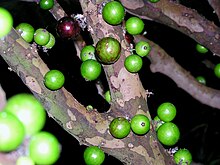| Plinia peruviana | |
|---|---|

| |
| Scientific classification | |
| Kingdom: | Plantae |
| Clade: | Tracheophytes |
| Clade: | Angiosperms |
| Clade: | Eudicots |
| Clade: | Rosids |
| Order: | Myrtales |
| Family: | Myrtaceae |
| Genus: | Plinia |
| Species: | P. peruviana |
| Binomial name | |
| Plinia peruviana (Poir.) Govaerts | |
| Synonyms | |
| |
Plinia peruviana, commonly known as jabuticaba cabinho (small stemmed jabuticaba) in Brazil, is a species of plant in the family Myrtaceae. It is endemic to central, South America.
Description
Plinia peruviana is a tree that grows to between 4 and 14 metres tall, and is usually found in mixed araucaria forests, on alluvial plains and in open forest. It produces edible fruit, between 18 and 25 mm in diameter, which is dark-purple in colour. Unlike other Jabuticabas the fruits of Plinia peruviana are connected to the tree by long stems, resembling cherries.
Uses
Fruits can be eaten fresh or made into jelly, juice, wine or liqueur. Research has shown that the fruit has potential uses as a dye, flavoring or antioxidant.
Studies have found that the jaboticaba fruit can serve as a wound healing agent on L929 fibroblasts cell line, likely due to its antioxidant activity. Jaboticaba has been used as a traditional natural medicine to treat skin irritations, diarrhea, etc.
It has also been found that extracts of the jaboticaba's peel can enrich cows milk with phenolic compounds. Phenolic compounds contain many antioxidants and are a natural part of the human diet. Enrichment of human consumed cow milk may aid in delivering antioxidants to the general population.
Extract from the fruit peel has been shown to be antifungal and protect against copper toxicity.
References
- "Plinia peruviana (Poir.) Govaerts". The Plant List. Retrieved 21 December 2020.
- "Plinia peruviana". Useful Tropical Plants. Retrieved 21 December 2020.
- Wua, Shi-Biao; Longa, Chunlin; Kennelly, Edward (2013). "Phytochemistry and health benefits of jaboticaba, an emerging fruitcrop from Brazil" (PDF). Food Research International. 54: 148–159. doi:10.1016/j.foodres.2013.06.021.
- "Jabuticaba para todos os gostos" (in Portuguese). Revista Natureza. June 13, 2018. Retrieved January 27, 2021.
- Susy Silveira, Sheila; Francisco Sant’Anna-Santos, Bruno; Degenhardt-Goldbach, Juliana; Quoirin, Marguerite (2020). "Somatic embryogenesis from mature split seeds of jaboticaba (Plinia peruviana (Poir) Govaerts)". Acta Scientiarum. Agronomy. 42.
- Wiszovaty, Lourdes; Caballero, Silvia; Oviedo, Cristian; Ozuna, Fernanda; Mereles, Laura (August 6, 2020). Plinia peruviana "Yvapurũ" Fruits and Marmalade from Paraguay: Autochthon Products with Antioxidant Potential. 2nd International Conference of Ia ValSe-Food Network. Lisbon, Portugal. doi:10.3390/proceedings2020053009. Retrieved February 4, 2021.
- Pitz, Heloisa da S.; Pereira, Aline; Blasius, Mayara B.; Voytena, Ana Paula L.; Affonso, Regina C. L.; Fanan, Simone; Trevisan, Adriana C. D.; Ribeiro-do-Valle, Rosa M.; Maraschin, Marcelo (2016-08-18). "In Vitro Evaluation of the Antioxidant Activity and Wound Healing Properties of Jaboticaba (Plinia peruviana) Fruit Peel Hydroalcoholic Extract". Oxidative Medicine and Cellular Longevity. 2016: e3403586. doi:10.1155/2016/3403586. ISSN 1942-0900. PMC 5007430. PMID 27630758.
- Di Maio, Gaetano; Pittia, Paola; Mazzarino, Letícia; Maraschin, Marcelo; Kuhnen, Shirley (2019-03-01). "Cow milk enriched with nanoencapsulated phenolic extract of jaboticaba (Plinia peruviana)". Journal of Food Science and Technology. 56 (3): 1165–1173. doi:10.1007/s13197-019-03579-y. ISSN 0975-8402. PMC 6423216. PMID 30956296.
- Waller, Stefanie; Peter, Cristina; Hoffmann, Jéssica; Cleff, Marlete; de Faria, Renata; Zani, João (2020). "Jabuticaba [Plinia peruviana (Poir.) Govaerts]: a Brazilian fruit with a promising application against itraconazole-susceptible and -resistant Sporothrix brasiliensis". Natural Product Research. 35 (24): 5988–5992. doi:10.1080/14786419.2020.1810034. PMID 32840143. S2CID 221309051. Retrieved December 21, 2020.
- Franscescon, F.; Mazon, S.C.; Bertoncello, K.T. (2018). "Protective role of jaboticaba Plinia peruviana peel extract in copper-induced cytotoxicity in Allium cepa". Environmental Science and Pollution Research. 25 (35): 35322–35329. Bibcode:2018ESPR...2535322F. doi:10.1007/s11356-018-3420-1. PMID 30341761. S2CID 53009912. Retrieved December 21, 2020.
| Taxon identifiers | |
|---|---|
| Plinia peruviana | |
This Myrtaceae article is a stub. You can help Misplaced Pages by expanding it. |